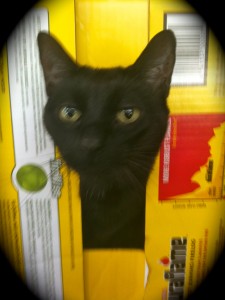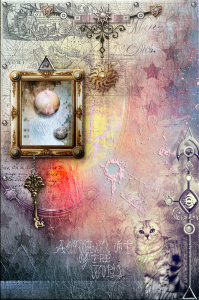When I first began to fall through the floor, I wasn’t sure what was happening. The kitchen seemed oddly distorted. The stripes of the wallpaper slanted a little to the left; the orange light of sunset lay over them like a flare of panic. My parents noticed nothing.
My mother was eating a fish sandwich, the McDonald’s wrapper neatly folded in front of her as she dabbed on mayonnaise. My father scraped the pickles and onions off his hamburger with his forefinger, which was streaked with the thick red of ketchup. Only my brother saw and looked at me as the chair’s back legs pierced the linoleum beneath my swinging feet and I tilted back with agonizing slowness.
I didn’t want to say anything at first. We usually didn’t talk much at the dinner table. Most of the time we didn’t eat at the table at all. My father brought home paper bags of food and set them on the counter so we could each take our share and vanish. Sometimes I sat on the grille of the heating vent. Warm air blew around my body. My brother crouched near me, both of us reading.
My father would take a glass of wine and his food and sit in front of the television. We could hear him twisting the dial back and forth to avoid the commercials. My mother sat in the living room near us, reading one of the romances which she devoured like french fries. We read science fiction and fantasy.
“Catherine’s falling,” my brother said.
My mother looked up. The chair angled more abruptly and I was on the floor. The chair was sprawled in front of me. Its back legs had nearly disappeared. I could see the ragged edges of the holes, like mouths forced open by stiff wooden rods.
My mother picked me up. I was crying now. My father pushed his chair back and looked at the floor. He continued to chew.
“That linoleum’s rotten,” he said. “I’ll have to fix it some time this weekend.”
Perhaps that makes him sound like a handyman, a fixer, someone who put things together. He wasn’t. Our house was broken hinges, stuck doors, worn carpets. Rather than take out a broken basement window, he piled dirt on the outside. To insulate it, he said. It made the basement a little darker, but that added to the mystery.
I liked to play there. Behind the furnace, there was a little space like a room. It smelled of house dust, dry air, and whiskey. I found a marble in a corner, amber colored glass. It was scratched in places where it had rolled across the cement floor. It would have been beautiful when it was new. When you held it up to your eye and looked through, everything was different, everything curved and bled together.
I took a half burned white candle from our dining room table down there. It was this which led to the basement being declared off-limits. My mother found the candle and thought I had been lighting it.
I liked having the candle there, in case there was a disaster, a tornado, an explosion, a nuclear bomb. Sometimes it was frightening in the basement. There were holes in the walls that led out in little tunnels and you couldn’t be sure something wasn’t watching you when your back was turned. I stuck the candle in a bottle. There were a lot of bottles down there, piled behind the furnace.
I could see the holes in the ceiling, between two smoke black beams, where the chair legs had gone through. The light from the kitchen came into the basement.
A month went by before the holes were repaired. We avoided the dent in the floor with its two accusing circles. Sometimes I imagined I felt the floor soften beneath my feet elsewhere in the kitchen and quickly stepped sideways. My brother and I watched each other when we were in the same room, as though afraid one might disappear and leave the other here alone.
Finally my father called a man in a blue hat, who came and tapped mysteriously in the basement. My brother and I sat up above, crosslegged on the floor, and watched the linoleum smooth itself out as he replaced the boards. The holes remained.
In the other room, my father watched a golf tournament. We could hear his breathing and sharp grunts whenever a putt rolled smoothly across the grass, heading into the hole like a ball with a purpose. When the man came up, my father offered him a beer and had my mother write out a check.
We went out to Happytime Pizza that night. The restaurant was clean; there were no holes in the floor. The windows were diamonds of colored glass, lead running like angry veins between them. The sunlight came through them and painted my father’s face with red and dark blue.
I reached my hand into a patch of green lying on the table’s surface and then took it out. No one was watching me. My mother and father held the menu between them. There was a wet ring on the wood of the table from my father’s beer glass. I put my hand into the color again and moved it back and forth, letting the light paint my hand as though smoothing it with color.
My brother kicked me gently under the table and moved his hand into the green too. We held our hands on either side of it, letting the very edge of the color bleed onto our hands, not daring to move in.
(originally appeared in The Cream City Review, selected by guest editor Frances Sherwood)






3 Responses
That made me smile 🙂
Fun take on King of the Cats.